Informal ASEAN+3 Finance and Central Bank Deputies Meeting, Presentation by Naoyuki Shinohara, Deputy Managing Director, International Monetary Fund
November 23, 2010
Presentation by Naoyuki Shinohara, Deputy Managing DirectorInternational Monetary Fund
Xi’an, China
November 23, 2010
As prepared for delivery
1. Good afternoon. It is an honor and a privilege indeed for me to address this ASEAN+3 meeting, and be once again among so many friends.
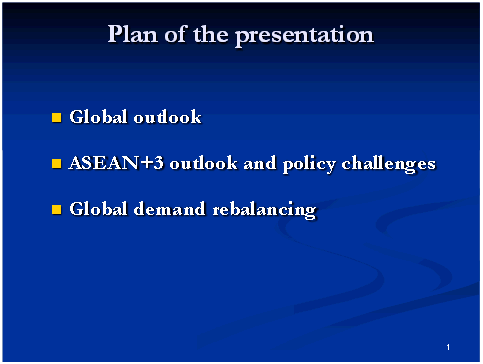
2. My presentation will cover three broad points. I will start with the global outlook and then consider the implications for ASEAN+3 economies. In doing so, I will focus in particular on the prospects for global demand rebalancing and the resulting challenges for macroeconomic management in the region. In a nutshell, we expect that ASEAN+3 economies continue their robust growth, but as the multi-speed global recovery proceeds, the policy challenges that emerged earlier this year are becoming more pressing. The time has come to exit from accommodative policies at a pace that is consistent with healthy private domestic demand growth. At the same time, capital inflows will need to be managed carefully, both in the short-term, but also over the medium-term with a view to facilitate economic rebalancing.
Global outlook: the multi-speed recovery is shifting gear
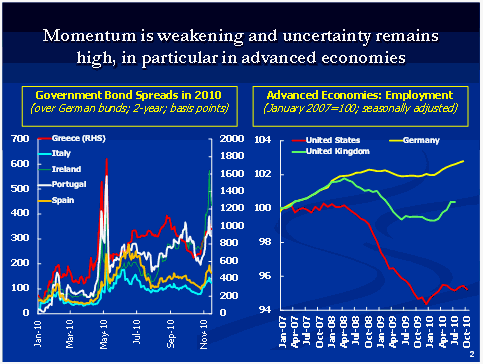
3. The global recovery has advanced despite setbacks to financial stability, but a number of indicators suggest the pace of recovery is slowing, including global trade flows and industrial production. However, emerging economies, especially in Asia, will remain in the lead. In these countries, activity is moderating from an exceptional pace set in the first half of the year. By contrast, in advanced economies, unemployment remains high and household consumption sluggish, suggesting that the strengthening of private domestic demand to support growth as policy stimulus and inventory rebuilding fade is proceeding only slowly.
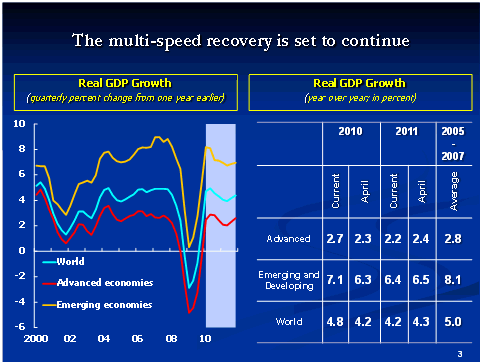
4. As a result, we expect world output to expand 4.8 percent this year, an upward revision of nearly half a percentage point relative to our April 2010 WEO forecast, and 4.3 percent next year. Advanced economies would expand by only 2.6 percent this year, a low rate considering that they are emerging from the deepest recession since World War II and that there is still significant excess capacity, in particular in Japan and the euro area. By contrast, growth in emerging and developing economies, while moderating in the second half of 2010, would still remain robust at 6.8 percent in 2010 and 6.4 percent in 2011.
5. Inflation will remain generally subdued, except in some emerging economies. In advanced economies, with core inflation slowing to less than 1 percent and considerable economic slack, deflation may be the more pertinent risk. In emerging economies, headline inflation is expected to subside to 5 percent in 2011, from over 6 percent in 2010, in part because commodity prices are expected to stabilize. However, inflationary pressures will be more elevated in economies that have had less stable inflation in the past, or are operating closer to capacity, such as India, for example.
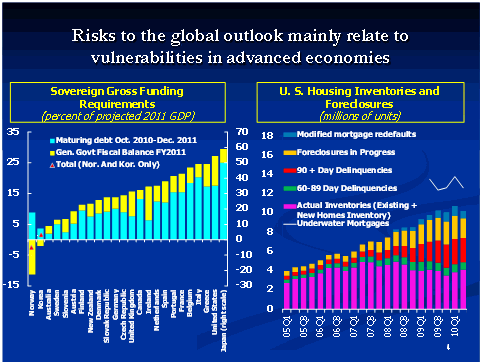
6. As the momentum of global activity has slowed, downside risks to the recovery have risen over the course of the year. In the main, these risks are not new. As private and financial sector balance sheets remain weak across a number of advanced economies, coupled with questions about fiscal sustainability and the recovery in real estate markets, a key risk is turbulence in advanced sovereign debt markets that could be triggered by unsuccessful debt rollovers or underperformance relative to fiscal consolidation plans. Such an event could create renewed financial market dislocations that interrupt the transition towards stronger private-led demand. A more marked slowdown in advanced economies together with heightened global risk aversion would quickly spread to developing and emerging economies through adverse feedback loops between real and financial sectors.
7. [In this regard and the current situation in Europe, I would like to say that, at the request of the Irish authorities, the IMF is working together with the European Commission and the European Central Bank in order to determine the best way to provide any necessary support to address market risks.]
8. Another risk to the outlook stems from the possibility of renewed weakness in key property markets, including the U.S., where the foreclosure backlog is large and growing. Against this background, advanced economies must begin implementing credible medium-term fiscal consolidation plans to anchor confidence and crowd in private demand. On the other hand, emerging market economies face risks of overheating from large capital inflows. Finally, without successful efforts at rebalancing global demand, the risk of protectionism would also likely rise.
Outlook for ASEAN+3
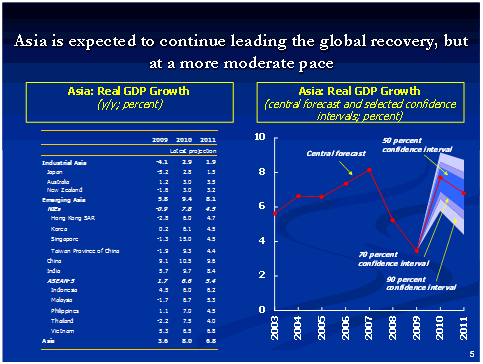
9. What are the implications for the ASEAN+3 outlook? Most ASEAN+3 economies, in particular the emerging ones, will grow vigorously in 2010 –– for example, for the ASEAN-5 our forecast has been revised up by 1 percentage point to 6½ percent. But the expansion will moderate and assume a more normal pace in 2011. This moderation mainly reflects the challenging outlook for exports as growth of final demand in advanced economies is unlikely to return to pre-crisis rates. China is likely to become a more important engine for external demand growth for other ASEAN+3 economies, but it is still a small market in comparison with large advanced economies, especially for consumer goods. Having said that, with Chinese domestic demand heavily biased towards the more commodities-intensive investment sectors, including infrastructure, capital goods exporters, such as Japan and Korea, and commodity exporters, such as Malaysia and Indonesia are set to benefit more from domestic demand growth in China.
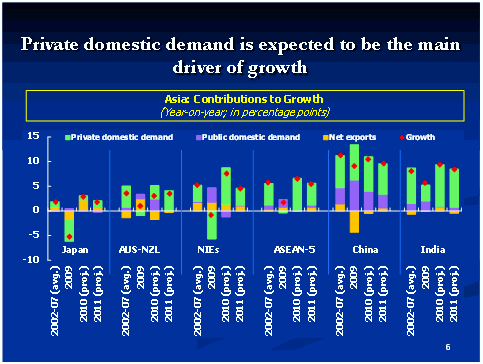
10. While the outlook for exports is relatively subdued, domestic demand in most ASEAN+3 economies should maintain a robust pace of expansion. Strong labor market conditions and consumer confidence point to healthy private consumption growth across most parts of the region, even in the absence of further policy stimulus. In the Philippines, private consumption will be further boosted by resilient remittance flows and, in Malaysia by a steady rise in rural incomes. Moreover, with manufacturing capacity utilization increasing sharply and, in some cases such as the Philippines, already close to full capacity, private investment should also maintain healthy growth. With bank credit growth turning the corner and lending spreads easing, domestic financial conditions should also remain favorable for further investment. Having said that, the moderation of export growth and increased uncertainty surrounding the global recovery might induce some moderation of investment.
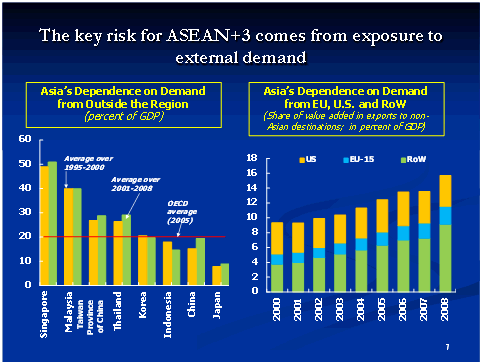
11. The main risks to this outlook are still on the downside and pertain to the global recovery. While economic fundamentals in the region are generally strong, important trade and financial linkages with the rest of the world would make Asian economies exposed to the downside risk of an advanced economy slowdown I described before. For example, final demand from the United States and the euro area accounts for an estimated 15 to 25 percent of value added produced in the smaller and more open ASEAN+3 economies. Therefore, a one percentage point decline in U.S. and euro area domestic demand could subtract about 1/3 percentage points on average from GDP growth across the region.
12. On the other hand, financial spillover risks appear generally more manageable for ASEAN+3 economies, given small overseas exposures by banks, including to the most vulnerable advanced economies in the euro area, strong shock absorbers, such as gross official reserves, that provide significant insurance in the event of foreign funding freezes, and low levels of government debt compared with other regions. However, an escalation of debt sustainability concerns in advanced economies and a jump in global risk premia would also raise financing costs across ASEAN+3 economies, in particular in those economies with relatively high public and/or external debt.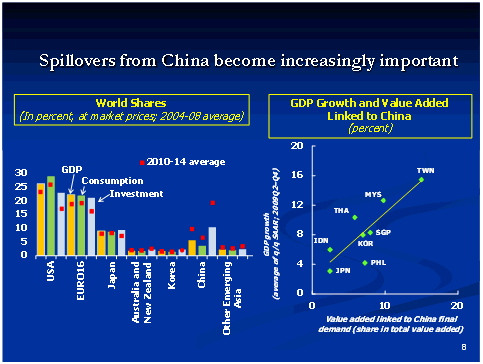
13. Within Asia, a more abrupt slowdown of economic activity in China constitutes a significant tail risk. Let me be clear that this is not our central forecast, especially since Q3 data point to continued robust activity in the Chinese economy. But if such an abrupt slowdown were to happen it would reverberate across the region, given the key role played by Chinese final demand in sustaining the regional recovery. Risks of a sharper-than-expected slowdown in China would increase if the deterioration in local public finances and banking sector asset quality from credit misallocation during the domestic stimulus program in 2009 turned out to be greater than envisaged. There are also increasing inflation pressures revealing themselves in China, largely as a result of food price increases but also due to rising housing costs. We have agreed with the government's strategy to steadily withdraw monetary stimulus in China. This rise in inflation further underlines the need to continue to tighten monetary conditions through both interest rate and exchange rate tools. In addition, in 2011, there is a good case to also begin withdrawing fiscal stimulus and reorienting the fiscal position away from infrastructure spending and toward measures designed to further raise household incomes and boost consumption.
Policy challenges
14. What are the key policy challenges in this uncertain, multi-speed global environment? I would like to highlight two. Let me first briefly review the challenge to manage the timing and scale of exit from policy stimulus, which is complicated by the challenges to manage capital inflows, and then discuss the medium-term challenge of rebalancing.
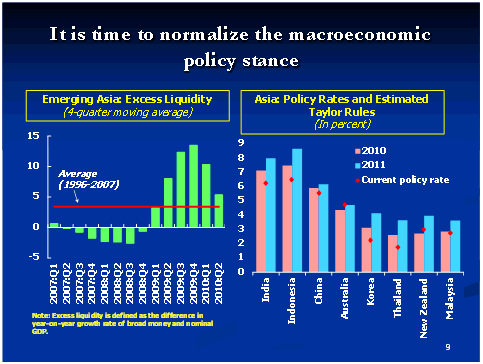
15. Measured against our baseline scenario of a continued global recovery and robust growth in the region, the normalization of monetary and fiscal policy conditions that began earlier this year is far from complete. First, excess liquidity, measured as the difference between broad money growth and nominal output growth, has declined, but remains above pre-crisis levels and also above its two-decade average. Likewise, real policy rates are still considerably below their pre-crisis levels and our estimates suggest that for most ASEAN+3 economies, except Malaysia, they are still well below levels consistent with stable inflation and zero output gaps, even after recent tightening measures. With resource utilization increasingly tight there is also the risk that second-round effects from spikes in food and energy prices could be amplified. Maintaining highly accommodative monetary conditions for too long could also lead to asset price inflation. Although increases in housing prices in a number of Asian economies are not per se evidence that a generalized housing bubble is building, history suggests that Asia is prone to asset boom-bust cycles during periods of excess liquidity.
16. I would like to add that greater exchange rate flexibility will be an important component of policy tightening. Recent capital inflow pressures in the region have been reflected mainly in international reserve accumulation, thereby contributing to excess liquidity. Continuing with recent steps to allow for stronger currencies would be more conducive to normalizing the policy stance and would also be more effective in managing volatile capital inflows.
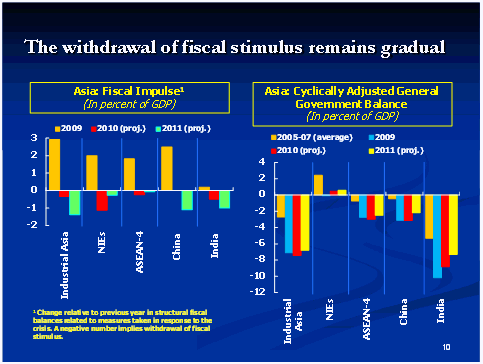
17. Fiscal policy should also play a role in making the overall macroeconomic policy stance less accommodative. Counter-cyclical fiscal policy can also help to buffer domestic demand against the impact of large capital inflows by contributing to lower interest rates and dampening currency appreciation. Having said that, in most ASEAN+3 economies debt sustainability is not a pressing concern thus affording a gradual pace of consolidation in light of the downside risks to the economic outlook. At the same time, a number of economies in the region will need to re-orient the composition of fiscal spending within the available envelope to further support infrastructure development. The infrastructure gap remains sizable in several economies in emerging Asia meaning that infrastructure investment is key for improving competitiveness and crowding in private investment.
18. To summarize our view on the appropriate exit from accommodative policies, let me say it is time for policy stances to be normalized across the region, now that the recovery is well established. Emerging Asia is leading the global recovery and, so far, policy makers have managed effectively the balance of macroeconomic risks. If downside risks materialize going forward, economies in the region have ample room to ease policies.
19. While we still need to carefully manage the exit from policy stimulus depending on country-circumstances, overall, policy priorities should increasingly focus on medium-term requirements, aimed at rebalancing global demand. This involves internal rebalancing in advanced economies, anchored by a shift from public- to private-demand-led growth, and external rebalancing, underpinned by an increase in net exports in advanced current account deficit countries and a decrease in net exports in emerging surplus economies. While this issue of global imbalances had been somewhat forgotten during the global economic crisis, recent concerns about “currency wars” throws light on this very important medium-term challenge.
20. Multilateral cooperation will be critical to promote external sustainability in countries and to support the pursuit of the full range of policies conducive to reducing excessive imbalances and maintaining current account imbalances at sustainable levels.
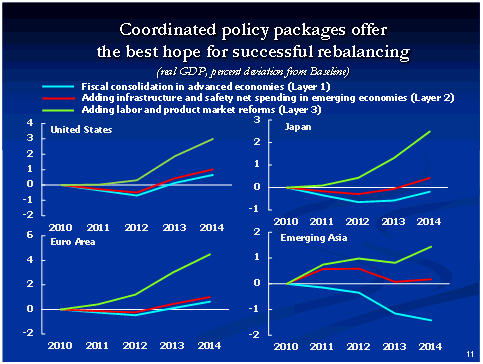
21. Advanced economies must expeditiously repair and reform financial sectors to normalize credit conditions and support internal rebalancing. This would help reduce the need for the highly accommodative monetary policy stance in these economies, which is contributing to negative spillovers in the form of large and volatile capital inflows to emerging economies and associated risks of overheating. Advanced economies should also put in place and begin implementing credible, growth-friendly, medium-term fiscal consolidation plans to help achieve sustainable fiscal positions while mitigating any short-term dampening impact on private demand. As part of these plans, consolidation should begin in 2011, but if global growth slowed appreciably more than expected, countries with fiscal room could postpone some of the planned consolidation.
22. In key emerging current account surplus economies, including in Asia, strategies to promote export-led growth will become less viable from a multilateral viewpoint, and eventually cause tensions as countries compete for a share of global demand. A reallocation of demand from the external sector may initially be painful for some sectors in these economies, but will lead to sizable and more sustainable gains in living standards over the medium-term. A successful shift of growth toward private domestic demand would require the simultaneous implementation of a package of measures depending on country circumstances. Such a package would include (i) a continued strengthening of social safety nets, which should help to further reduce precautionary saving and thus boost consumption (especially in China); (ii) further advances in financial sector reforms, which can support private consumption as well as investment; and (iii) more exchange rate flexibility, which will boost household disposable income and facilitate the shifting of resources to non-tradable sectors. In order for these measures to be most effective, they need to be undertaken widely in coordination with other global players.
23. Many emerging economies in Asia and elsewhere are also faced with the difficult policy challenge of managing large and volatile capital inflows as we will discuss in greater detail tomorrow. In the context of global demand rebalancing, these flows should be viewed as an opportunity to facilitate adjustment towards broader-based growth, not as a hindrance. Having said that, managing large inflows will be a challenge and the task becomes more onerous in the context of limited exchange rate flexibility in some major emerging market economies. The appropriate response will need to be based on whether capital inflows are assessed to be permanent or transitory, the exchange rate is fairly valued, reserves are adequate and if there are risks of overheating.
G20 achievements and role of the Fund
24. I would like to conclude my remarks on global rebalancing by saying that the actions announced at the G20 leaders summit in Seoul will play an important role in strengthening the international policy framework to help sustain the global economic recovery. A number of decisions of the summit and the IMF’s role in implementing them are worth highlighting. First is the agreement to continue with the Mutual Assessment Process for which the Fund together with other organizations will advise on indicative guidelines to help identify large imbalances that require preventive and corrective actions. In this context, we will modernize our surveillance instruments including through new country-specific spillover reports on the wider impact of systemic economies’ policies. Second, the G20 welcomed the strengthening of the IMF’s lending toolkit, such as the enhancement of the flexible credit line, which plays a key-role in enhancing global financial safety nets. But the Fund is also ready to deepen its work on other aspects of the international monetary system, including capital flows volatility. Third, the G20 endorsement of a new financial regulatory framework will be complemented by the mandatory Financial Sector Assessment Program through the IMF and World Bank for countries with systemically important financial sectors. Finally, the G20 endorsed important governance changes at the IMF, which will bring greater representation of dynamic emerging markets and developing countries, including many ASEAN+3 members.
Conclusion
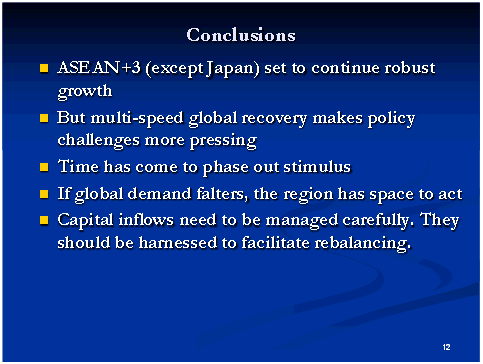
25. Summing up, ASEAN+3 economies are set to continue their robust growth but the prospects for strong external demand are challenging, given the sluggish recovery and dwindling policy space in advanced economies. Moreover, as the multi-speed recovery proceeds, the policy challenges that emerged earlier this year are becoming more pressing. The time has come to exit from accommodative policies at a pace that is consistent with healthy private domestic demand growth. At the same time, capital inflows will need to be managed carefully, both in the short-term, but also over the medium-term with a view to facilitate economic rebalancing. The IMF looks forward to working together with policymakers in the region on all these issues, through bilateral surveillance, participation in regional meetings like this one, and strengthening our regional analytical work. Moreover, the upcoming IMF conference on capital flows in Bali in March 2011 will provide an opportunity to further share views and lessons on this important issue. Finally, I should mention that the Fund is also strengthening its links with regional financial safety nets. During the recent Annual Meetings, the IMF hosted its first seminar on regional financial safety nets, which saw participation from Asia, Europe, Latin America, and the Middle East.
Thank you.
IMF COMMUNICATIONS DEPARTMENT
| Public Affairs | Media Relations | |||
|---|---|---|---|---|
| E-mail: | publicaffairs@imf.org | E-mail: | media@imf.org | |
| Fax: | 202-623-6220 | Phone: | 202-623-7100 | |







